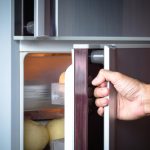 A refrigerator is an essential appliance in any home, keeping our food cool and fresh. However, there are times when we may notice that our fridge is not maintaining the desired temperature, leading to warm food and potential spoilage. In this blog post, we will explore some common reasons why your fridge may be warm and discuss possible solutions.
A refrigerator is an essential appliance in any home, keeping our food cool and fresh. However, there are times when we may notice that our fridge is not maintaining the desired temperature, leading to warm food and potential spoilage. In this blog post, we will explore some common reasons why your fridge may be warm and discuss possible solutions.
1. Improper Temperature Settings:
One of the most straightforward explanations for a warm fridge is incorrect temperature settings. It is crucial to ensure that the temperature controls are set to the appropriate levels. The ideal refrigerator temperature is generally between 35 and 38 degrees Fahrenheit (1.6 to 3.3 degrees Celsius). Check the thermostat settings and adjust them if needed.
2. Blocked Air Vents:
Air vents in the refrigerator and freezer compartments allow for proper air circulation, which is essential for maintaining consistent temperatures. If these vents are blocked by food items or other obstructions, restricted airflow can cause the fridge to become warm. Check and rearrange the contents of your fridge to ensure that nothing is obstructing the air vents.
3. Dirty Condenser Coils:
The condenser coils at the back or underneath your refrigerator are responsible for releasing heat, allowing the fridge to cool down. Over time, these coils can accumulate dust, debris, and pet hair, hindering their ability to dissipate heat efficiently. A dirty condenser coil can result in warm temperatures inside the fridge. Vacuum or brush off any visible dirt or use a coil cleaning brush to remove stubborn debris.
4. Malfunctioning Evaporator Fan:
The evaporator fan is responsible for circulating cold air throughout the refrigerator and freezer compartments. A malfunctioning fan can disrupt the airflow, causing inconsistent cooling and a warm fridge. Listen for unusual noises coming from the back of the fridge, as this may indicate a problem with the evaporator fan. If you suspect a faulty fan, it is best to call a professional appliance technician for repair or replacement.
5. Faulty Door Seals:
The door seals, also known as gaskets, create an airtight seal when the refrigerator door is closed. If these seals are worn out or damaged, warm air from the outside can enter the fridge, causing it to warm up. Inspect the door seals for any signs of wear, tears, or gaps. Replace the faulty seals to ensure a proper seal and maintain the desired temperature inside the fridge.
6. Overcrowded Fridge:
An overcrowded fridge can impede proper air circulation, preventing cold air from reaching all areas of the refrigerator. This can result in warm spots and uneven cooling. Evaluate the contents of your fridge and organize it in a way that allows for adequate airflow. Remove any unnecessary items or consider moving some to the freezer if space is limited.
7. Faulty Temperature Sensor:
Modern refrigerators are equipped with temperature sensors that monitor the internal temperatures and adjust cooling accordingly. If the temperature sensor is faulty or inaccurate, the fridge may not be getting the correct readings, leading to warm temperatures. Consult the user manual or contact the manufacturer for guidance on how to test or replace the temperature sensor.
Summary:
A warm refrigerator can lead to spoiled food and inconvenience. By understanding the common reasons behind a warm fridge and taking necessary precautions, you can ensure the proper functioning and longevity of your refrigerator. Remember to check temperature settings, maintain proper airflow, clean condenser coils, and address any faulty components promptly. If problems persist, it is always recommended to seek professional appliance repair services to avoid further damage.
